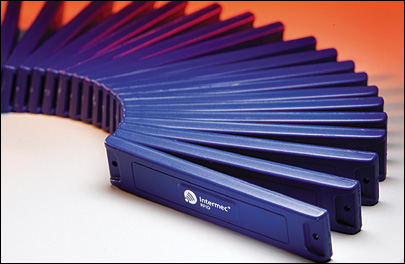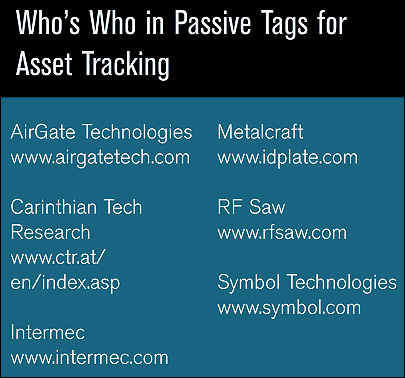Companies such as Intermec and Symbol Technologies are making rugged, reusable Electronic Product Code Gen 2 tags that have a longer read range and greater memory capacity than earlier ultrahigh-frequency passive tags. Shoppers Drug Mart recently completed a technology trial using passive tags to track cargo trailers throughout its transportation yard.
Logistics firm Exel partnered with Symbol and Fluensee, a startup that makes asset-tracking software, to deploy the Shoppers Drug Mart pilot. The Canadian retailer is currently examining the results of the trial to determine the business case, but the Symbol tag performed even better than anticipated, according to Chris Brumett, Fluensee’s vice president of operations. “Symbol recently updated the tag,” he says, “and we were seeing a read range of 30 to 45 feet consistently.” Symbol attributes the increased range to the tag’s antenna design, and to the use of a metal plate behind the tag, which amplifies the tag’s backscatter signal.

While that range is far less than the typical 300 feet of read range that active tags provide, the lower range comes with a significantly lower cost: Passive tags range from less than $10 to $15 each, compared with $50 or more for an active tag.
“People are realizing the cost trade-off between active and passive technology,” says Clyde Church, RFID sales manager for Metalcraft, a company that embeds passive inlays into rugged housing, which lessens or eliminates RF interference generated by metal-something that has limited the types of assets passive RFID could be used to track. “They say, ‘Maybe I don’t need the 150 feet of range I can get with an active tag,'” when a passive tag costs significantly less.
In asset-tracking systems that use active tags, a few fixed-position interrogators are installed throughout a facility. But that setup won’t suffice to read the shorter-range passive tags. Fluensee and Pinc Solutions, a yard management/asset-tracking startup, have developed systems that use mobile interrogators located inside the trucks that move the tagged trailers around the yard. The interrogators read the tags both on the trailers the trucks are moving and on trailers they pass while driving around the yard. They send all the IDs wirelessly to back-end systems. By correlating the read time with the truck’s coordinates from an onboard GPS receiver, the Fluensee and Pinc software can pinpoint the tagged trailers’ locations in the yard.
Another type of passive tag being used for asset tracking, especially where environmental monitoring also is needed, is based on surface acoustic wave (SAW) technology. AirGate Technologies, Carinthian Tech Research (CTR) and RF Saw sell passive SAW tags that operate in the 2.45 GHz band, can be read from up to 300 feet away, can be read on and near metal and water, and can track temperature, shock or pressure. Systems integrator Advanced Research is using SAW tags for its OpenCrib application to track tools and parts in large storage bins or cribs.


